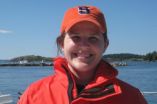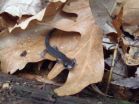(Press-News.org) Remote acoustic monitoring among endangered whales is the subject of a major article by two doctoral students in Syracuse University's College of Arts and Sciences.
Leanna Matthews and Jessica McCordic, members of the Parks Lab in the Department of Biology, have co-authored "Remote Acoustic Monitoring of North Atlantic Right Whales Reveals Seasonal and Diel Variations in Acoustic Behavior." The article appears in the current issue of PLOS ONE, an inclusive, peer-reviewed, open-access resource from the Public Library of Science in San Francisco, Calif.
Susan Parks, assistant professor of biology for whom the lab is named, says the article confirms what many conservationists fear—that Roseway Basin, a heavily traveled shipping lane, off the coast of Nova Scotia, is a vital habitat area for the endangered North Atlantic right whale.
"Remote acoustic monitoring is an important tool for understanding patterns in animal communication, and studies on the seasonality of context-specific acoustic signals allow inferences to be made about the behavior and habitat use of certain species," says Parks, an expert in behavioral ecology, acoustic communication, and marine science. "Our results support the hypothesis that the North Atlantic right whale's breeding season occurs mostly from August to November and that this basin is a widely used habitat area."
More than 30 percent of all right whales use Roseway Basin, part of a larger geological formation called the Scotian Shelf, throughout the year. With only 400-500 in existence, these whales, says Parks, must congregate in the basin to feed and find mates.
Already, the U.S. and Canadian governments have taken steps to redirect shipping traffic, in response to several fatal collisions with right whales.
Matthews, whose research includes animal behavior and physiology, says the object of the article is to determine how and when Roseway Basin is used for male breeding activities.
"Part of the answer lies in a loud 'gunshot' sound, made by the male whale," says Matthews, the article's lead author. "We're not exactly sure what the gunshot is, but we think it may be a male-to-male antagonistic signal or an advertisement to females. ... During a two-year period, we used non-invasive acoustic monitoring to analyze gunshots at two locations on the Scotian Shelf. The resultant data has provided tremendous insights into the whales' feeding and mating habits."
Matthews and her team found that gunshot sound production occurred mainly in the autumn and, more often than not, at night. Researchers say this kind of information is essential to not only the individual fitness of each whale, but also the survival of the species, in general.
McCordic, whose research spans animal behavior and communication, says the observed seasonal increase in gunshot sound production is consistent with the current understanding of the right whale breeding season.
"Our results demonstrate that detection of gunshots with remote acoustic monitoring can be a reliable way to track shifts in distribution and changes in acoustic behavior, including possible mating activities," she says, acknowledging David Mellinger, associate professor of marine bioacoustics at Oregon State University, who collected and provided access to the recordings used in the study. "It also provides a better understanding of right whale behavior and what needs to be done with future conservation efforts."
Parks, who assisted with the article, is proud of her students' accomplishments.
"Right whales are increasingly rare, and Leanna's and Jessica's research helps us understand how to better protect them," she says. "By identifying potential breeding areas, we might be able to save this critically endangered species."
INFORMATION:
Located in SU's Life Sciences Complex, the Department of Biology offers graduate and undergraduate programs in cell biology, development, neuroscience, ecology, evolution, pre-medical education, and environmental
SU biologists use sound to identify breeding grounds of endangered whales
Remote acoustic monitoring of North Atlantic right whales reveals seasonal and diel variations in acoustic behavior
2014-03-25
ELSE PRESS RELEASES FROM THIS DATE:
In search of a few good apps
2014-03-25
BOSTON–While the Food and Drug Administration (FDA) has released guidelines for the regulation of mobile health (mHealth) apps that act as medical devices or as accessories to medical devices, the vast majority of mHealth apps remain unregulated and unevaluated. In a Viewpoint article, "In Search of a Few Good Apps", published in JAMA on March 24, 214, co-authors, David Bates, MD and Adam Landman, MD of Brigham and Women's Hospital (BWH) and Adam Powell, PhD, president of Payer+Provider Syndicate, call for the creation of mHealth (mobile health) app review and certification ...
Study: Salamanders shrinking due to climate change
2014-03-25
Wild salamanders living in some of North America's best salamander habitat are getting smaller as their surroundings get warmer and drier, forcing them to burn more energy in a changing climate.
That's the key finding of a new study co-authored by a Clemson University biologist and published Tuesday in the journal Global Change Biology that examined museum specimens caught in the Appalachian Mountains from 1957 to 2007 and wild salamanders measured at the same sites in 2011-2012.
The salamanders studied from 1980 onward were, on average, eight percent smaller than their ...
Nanotube coating helps shrink mass spectrometers
2014-03-25
WEST LAFAYETTE, Ind. — Nanotechnology is advancing tools likened to Star Trek's "tricorder" that perform on-the-spot chemical analysis for a range of applications including medical testing, explosives detection and food safety.
Researchers found that when paper used to collect a sample was coated with carbon nanotubes, the voltage required was 1,000 times reduced, the signal was sharpened and the equipment was able to capture far more delicate molecules.
A team of researchers from Purdue University and the Indian Institute of Technology Madras performed the study, which ...
Model predicts blood glucose levels 30 minutes later
2014-03-25
A mathematical model created by Penn State researchers can predict with more than 90 percent accuracy the blood glucose levels of individuals with type 1 diabetes up to 30 minutes in advance of imminent changes in their levels -- plenty of time to take preventative action.
"Many people with type 1 diabetes use continuous glucose monitors, which examine the fluid underneath the skin," said Peter Molenaar, Distinguished Professor of Human Development and Family Studies and of psychology. "But the glucose levels under the skin trail blood glucose levels from anywhere between ...
NASA satellite sees wind shear whipping Tropical Cyclone Gillian
2014-03-25
A visible image from NASA's Aqua satellite provides a clear picture that wind shear is responsible for weakening the once mighty Tropical Cyclone Gillian from hurricane to tropical storm strength.
When NASA's Aqua satellite flew over Gillian on March 25 at 06:30 UTC/2:30 a.m. EDT, the Moderate Resolution Imaging Spectroradiometer or MODIS instrument took a visible picture of the storm. That image showed that wind shear has pushed clouds and showers away from the center as the storm weakened to a tropical storm.
In the MODIS image, the center of Gillian's circulation ...
Haynes is first to identify cellular patterns of contraction in human hearts
2014-03-25
LEXINGTON, Ky. (March 19, 2014) — When Premi Haynes was growing up in Pune, India, she attended Stella Maris High School, an English language convent school founded by Swiss nuns. Her second grade singing class used a book of English songs. One of the songs was "My Old Kentucky Home." At that time, Haynes had never heard of Kentucky, had no idea where it was, and had no particular ambition to go there.
Some 20 years and a twist of fate later, on March 19 Haynes successfully defended her Ph.D. thesis in physiology at the University of Kentucky, where she's made a significant ...
Agricultural fires across Sierra Leone
2014-03-25
Marked in red, hundreds of land use fires burn in the fields across Sierra Leone. Most fires in this region are deliberately set for a variety of reasons, including slash and burn agriculture. When a plot of land becomes exhausted, farmers shift cultivation to another plot where they cut the trees and brush at the beginning of the dry season in January and February. Once the dead plant material has dried, they set fire to it. Such fires peak in March and April right before farming season begins.
From space, MODIS detects thermal anomalies, including fires, flares, and ...
Sensing gravity with acid
2014-03-25
WOODS HOLE, Mass.—While probing how organisms sense gravity and acceleration, scientists at the Marine Biological Laboratory (MBL) and the University of Utah uncovered evidence that acid (proton concentration) plays a key role in communication between neurons. The surprising discovery is reported this week in Proceedings of the National Academy of Sciences.
The team, led by the late MBL senior scientist Stephen M. Highstein, discovered that sensory cells in the inner ear continuously transmit information on orientation of the head relative to gravity and low-frequency ...
Understanding plant-soil interaction could lead to new ways to combat weeds
2014-03-25
URBANA, Ill. – Using high-powered DNA-based tools, a recent study at the University of Illinois identified soil microbes that negatively affect ragweed and provided a new understanding of the complex relationships going on beneath the soil surface between plants and microorganisms.
"Plant scientists have been studying plant-soil feedback for decades," said U of I microbial ecologist Tony Yannarell. "Some microbes are famous for their ability to change the soil, such as the microbes that are associated with legumes—we knew about those bacteria. But now we have the ability ...
Patient safety merits new review for modified medical devices, physician says
2014-03-25
For patient safety, the U.S. Food and Drug Administration (FDA) should require that clinical data be submitted as part of a more rigorous re-evaluation of medical devices that are modified after approval, according to UC San Francisco physician scientists in a commentary published online March 24, 2014 in the Annals of Internal Medicine. According to authors Rita Redberg, MD, UCSF professor of medicine, and UCSF second-year medical student Sarah Zheng, such a requirement could prevent deaths due to insufficiently tested device modifications.
"The need for rapid approval ...
LAST 30 PRESS RELEASES:
New fossil study illuminates on the evolutionary success of frogs
Patient-specific human liver model to understand disease mechanisms
Confused by the doctor's questionnaire? U of A study suggests it's common
How do brains stay stable, and when might a dose of flexibility be helpful?
mRNA revitalizes aging immune systems—the liver as a fountain of youth
Rural-urban differences in the prevalence of chronic pain among adult cancer survivors
Food insecurity, burnout, and social isolation among resident and fellow physicians
How do spinal cord injuries heal?
Detailed cell map unlocks secrets of how reproductive organs form
Large language models unleash AI’s potential for autonomous and explainable materials discovery
Gut bacteria have evolved rapidly to digest starches in ultra-processed foods
New risk score helps predict pancreatic cancer recurrence
New evidence challenges understanding of Parkinson’s disease
A new study reveals how embryos and the uterus “talk” during implantation
Cedars-Sinai reports heart attacks, general illness spiked after LA fires
PolyU develops ultra-stable, mucus-inspired hydrogel to boost gastrointestinal wound healing
Flour choice shapes sourdough microbial communities
Can a retinal implant reverse macular degeneration?
Feeding fungi plant remnants produces tasty protein to fortify vegan, vegetarian diets
New tech reduces false positives from breast ultrasounds
Drone-mounted lab monitors fertilizer runoff in real time
Short, light-intensity exercise boosts executive function and elevates mood in children
Jeonbuk National University researchers reveal new interface engineering strategy for efficient and stable back-contact solar cells
Tyrosinase drives hydroquinone-induced exogenous ochronosis: not HGD inhibition
UMass Amherst chemists develop unique tool for studying RNA
Disappointment alters brain chemistry and behavior
A built-in odometer: new study reveals how the brain measures distance
Stress-related brain signals drive risk of cardiovascular disease in people with depression and anxiety
New details on role of fat transport molecules in Alzheimer’s onset
Study illuminates how an antiviral defense mechanism may lead to Alzheimer’s disease
[Press-News.org] SU biologists use sound to identify breeding grounds of endangered whalesRemote acoustic monitoring of North Atlantic right whales reveals seasonal and diel variations in acoustic behavior








